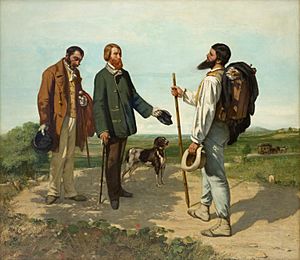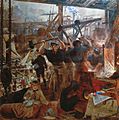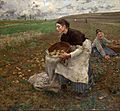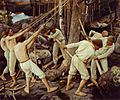Realism facts for kids
Realism is a way of showing things exactly as they are, especially in art, literature, and music. It became popular in the late 1800s. Instead of imagining fantasy worlds, artists wanted to show real life, nature, and how people lived in society.

Contents
Realism in Art and Painting
In painting, Realism meant showing everyday life and ordinary people, not just heroes or grand historical events. Artists like Gustave Courbet were very important in this movement. They wanted their paintings to look as real as possible.
For example, Courbet's painting The Stone Breakers showed two ordinary workers breaking rocks. This was different from earlier art that often focused on more "beautiful" or "important" subjects. Realist painters believed that even simple, everyday scenes were worth painting.
Realism in Literature
Realism in literature meant writers tried to describe the world and people's lives accurately. They focused on showing characters and situations as they truly were, without making them seem more exciting or romantic than they were.
A German writer named Heinrich Heine was one of the first to explore these ideas. Later, a movement called Naturalism grew from Realism. Naturalist writers, like Emile Zola, went even further, describing scenes in nature and society with great detail and honesty.
Realism in Music
In music, there was a style called Verismo, which is an Italian word meaning "reality." Verismo was popular in Italian opera around the late 1800s and early 1900s.
Composers who wrote Verismo operas tried to show real-life stories and emotions. They often focused on the lives of ordinary people and their everyday problems. Puccini was a famous opera composer whose music is a great example of the Verismo style. His operas often feature strong emotions and dramatic, realistic plots.
Realism in Philosophy
In philosophy, Realism has a slightly different meaning. It's a way of thinking that says things exist in the world whether or not anyone is looking at them, hearing them, or touching them.
For example, some older philosophers believed that something like "beauty" only existed because someone saw something and thought it was beautiful. But a Realist philosopher would say that beauty is there, in the object itself, even if no one is around to see it. It exists independently of our minds.
Images for kids
-
The Stone Breakers was a painting by Gustave Courbet, done in 1849. It was lost in a fire, in 1945.
-
Realist or illusionistic detail of the convex mirror in the Arnolfini Portrait by Jan van Eyck, 1434
-
Lord Leighton's Cimabue's Celebrated Madonna of 1853–55 is at the end of a long tradition of illusionism in painting, but is not Realist in the sense of Courbet's work of the same period.
-
Bas-de-page of the Baptism of Christ, "Hand G" (Jan van Eyck?), Turin-Milan Hours. An advanced illusionistic work for c. 1425, with the dove of the Holy Ghost in the sky.
-
Diego Velázquez, The Farmers' Lunch, c. 1620
-
Giacomo Ceruti, Women Working on Pillow Lace, 1720s
-
Jean-Baptiste-Siméon Chardin, Woman Cleaning Turnips, c. 1738, Alte Pinakothek.
-
Jean-Baptiste Greuze, The Laundress, 1761
-
Albert Edelfelt, The Luxembourg Gardens. 1887
-
Gustave Courbet, Stone-Breakers, 1849
-
Jean-François Millet, The Gleaners, 1857
-
Honoré Daumier, Les Joueurs d'échecs (The chess players), 1863
-
Jean-Baptiste-Camille Corot, Young Girl Reading, 1868
-
Jules Bastien-Lepage, October, 1878, National Gallery of Victoria
-
Ilya Repin, Religious Procession in Kursk Province, 1880–1883
-
William Bliss Baker, American Naturalist painter, Fallen Monarchs, 1886
-
Pekka Halonen, Finnish Naturalist, Pioneers in Karelia, 1900
See also
 In Spanish: Realismo para niños
In Spanish: Realismo para niños
































